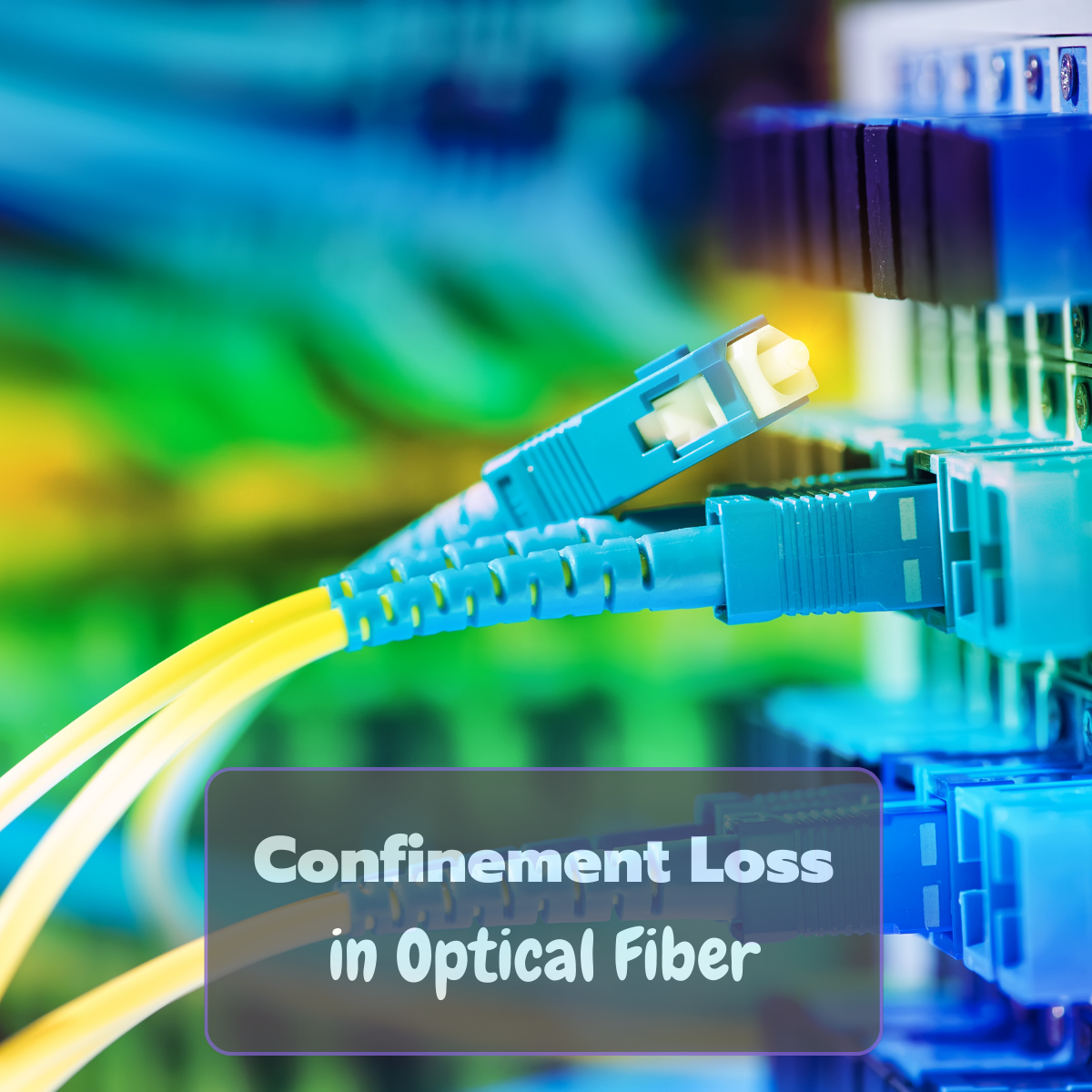
Dive into the world of optical fiber technology and understand what confinement loss is, its impact on optical fiber performance, and the innovative solutions to mitigate it.
Introduction to Optical Fiber Technology
Optical fibers are the backbone of modern communication, enabling the transmission of data over long distances with minimal loss. At the heart of this technology lies the principle of light confinement within the fiber’s core, which is crucial for efficient signal transmission. However, this confinement is not perfect, leading to what is known as confinement loss. Understanding this phenomenon is key to optimizing fiber optic networks and enhancing communication systems.
Understanding Confinement Loss
Confinement loss refers to the leakage of light from the core of the optical fiber into the cladding, or even outside the fiber, resulting in signal attenuation. This loss is particularly significant in fibers designed for long-distance communication or in those with a small core diameter, where maintaining the confinement of light becomes challenging.
Mitigating Confinement Loss
Reducing confinement loss is crucial for maximizing the efficiency and performance of optical fiber systems. Strategies include:
- Optimizing Fiber Design: Tailoring the core and cladding refractive indices and geometries to minimize loss.
- Improving Fabrication Quality: Ensuring the fiber material is free from defects that could scatter light.
- Careful Handling: Avoiding sharp bends and maintaining optimal environmental conditions during installation and use.
Factors Affecting Confinement Loss
Several factors contribute to confinement loss, including the fiber’s design, the wavelength of the transmitted light, and the refractive index contrast between the core and cladding. Understanding these factors is crucial for minimizing loss and improving fiber optic performance.
| Factor | Description |
| Mode Field Diameter (MFD) | Larger MFDs can lead to increased confinement loss as the light extends further into the cladding. |
| Wavelength | Longer wavelengths are more prone to confinement loss due to their larger mode size. |
| Fiber Geometry | Tapers, bends, and irregularities can exacerbate loss by disturbing the mode confinement. |
| Refractive Index Difference | A lower contrast between core and cladding refractive indices can reduce confinement efficiency. |
The Physics Behind Confinement Loss
The phenomenon of total internal reflection is central to the operation of optical fibers, ensuring that light is guided along the fiber’s length. However, imperfections in the fiber structure or deviations in the light’s angle of incidence can disrupt this process, leading to confinement loss.
The primary mechanism behind confinement loss is the imperfect guidance of light within the fiber core. In an ideal scenario, the core’s refractive index is designed to be slightly higher than that of the cladding, ensuring that light is kept within the core through total internal reflection. However, several factors can disrupt this delicate balance:
- Bending Loss: When an optical fiber is bent, the outermost rays can penetrate deeper into the cladding, leading to leakage.
- Scattering Loss: Microscopic imperfections in the fiber material can scatter light, diverting it from its intended path.
- Mode Mismatch: Incompatibilities between the fiber mode and the light source can lead to inefficient coupling, with some light failing to be confined.
The Role of the Cladding and Core in Confinement
The cladding and core of an optical fiber work together to contain the light within the core. Any mismatch or imperfection can result in partial leakage of light, manifesting as confinement loss.
Measuring Confinement Loss
Measuring confinement loss in optical fibers is essential for diagnosing and enhancing fiber optic system performance. Techniques like the cutback method, where a fiber’s loss is measured before and after shortening its length, provide insights into loss characteristics over distance. Optical time-domain reflectometry (OTDR) is another advanced method that maps loss along the fiber’s length, identifying specific regions where confinement loss may be higher.
Techniques for Measuring Confinement Loss
Various techniques are employed to measure confinement loss, including cut-back methods, optical time-domain reflectometry, and others. These measurements help in diagnosing issues and improving fiber designs.
Interpretation of Measurement Results
Understanding the results of confinement loss measurements is critical for diagnosing issues within the fiber and for implementing corrective actions to minimize loss.
Implications of Confinement Loss
The implications of confinement loss in optical fibers are profound, extending across the spectrum of telecommunications and data transmission. This form of loss directly influences the efficiency and reliability of fiber optic networks, dictating the quality of information flow over vast distances.
Impact on Signal Quality
Confinement loss directly impacts the quality of the transmitted signal, leading to degradation in performance, especially over long distances.
Challenges in Long-Distance Communication
For long-distance communication, minimizing confinement loss is paramount to maintaining signal integrity and ensuring efficient data transmission.
Reducing Confinement Loss in Optical Fibers
Reducing confinement loss in optical fibers is pivotal for enhancing the performance and efficiency of fiber optic communication systems. Efforts to minimize this loss focus on innovations in fiber design, such as refining the core-to-cladding refractive index contrast and employing photonic crystal structures that improve light confinement.
Material Innovations
Advancements in materials used for the core and cladding have shown promise in reducing confinement loss, thereby enhancing the efficiency of optical fibers.
Design and Structural Innovations
Innovations in the design and structure of optical fibers, including the introduction of photonic crystal fibers, have been effective in minimizing confinement loss.
Future Trends in Optical Fiber Technology
The future of optical fiber technology holds promising advancements aimed at further reducing confinement loss and enhancing communication systems.
Conclusion and Future Outlook
Confinement loss is a critical consideration in the design and operation of optical fiber systems, impacting signal strength and integrity. Through a deeper understanding of its causes and mitigation strategies, we can harness the full potential of optical fiber technology for a myriad of applications, from internet infrastructure to medical imaging. As we advance, the continued refinement of fiber designs and manufacturing processes will be paramount in minimizing confinement loss, ensuring that optical fibers remain at the forefront of technological innovation.
FAQs on Confinement Loss in Optical Fibers
- How does confinement loss affect the performance of optical fibers?Confinement loss leads to a reduction in the intensity of the light signal as it travels through the optical fiber. This diminishes the signal quality and efficiency, affecting the overall performance of the fiber. As a result, data transmission over long distances can suffer from increased error rates and decreased bandwidth, necessitating more frequent signal amplifications or regeneration.
- What are the primary factors contributing to confinement loss?Several key factors influence confinement loss in optical fibers:
- Core and Cladding Refractive Index Difference: A smaller difference can lead to weaker confinement of light.
- Fiber Geometry and Design: Imperfections or variations in the fiber's diameter can affect light propagation.
- Wavelength of Light: Light at certain wavelengths may be more prone to escaping the core, especially in fibers not optimized for that specific wavelength.
- Quality of the Fiber Material: Impurities and irregularities in the core and cladding materials can also lead to increased loss.
- How is confinement loss measured in optical fibers?Confinement loss is typically measured using techniques such as the cutback method, where a long length of fiber is first measured for its loss characteristics, then cut back to a shorter length and measured again. The difference in loss provides an indication of the confinement loss. Other methods include optical time-domain reflectometry (OTDR), which can also help identify loss along the fiber length.
- Can confinement loss in optical fibers be completely eliminated?While it is challenging to completely eliminate confinement loss due to inherent physical and material limitations, it can be significantly minimized through careful design and optimization of the fiber structure, material selection, and operating conditions. Ongoing advancements in fiber technology continually reduce confinement losses to negligible levels for many practical applications.
- What are the latest advancements in reducing confinement loss?Innovations aimed at reducing confinement loss include:
- Photonic Crystal Fibers (PCFs): These fibers use a periodic array of air holes in the cladding to confine light more effectively.
- Improved Material Purity: Advances in manufacturing have led to purer glass materials, reducing imperfections that can lead to loss.

